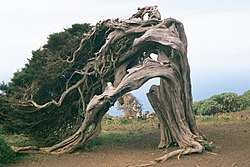| Juniperus canariensis | |
|---|---|
 | |
| Old specimen at El Sabinar, El Hierro, Canary Islands (Spain) | |
| Scientific classification | |
| Kingdom: | Plantae |
| Clade: | Tracheophytes |
| Clade: | Gymnospermae |
| Division: | Pinophyta |
| Class: | Pinopsida |
| Order: | Cupressales |
| Family: | Cupressaceae |
| Genus: | Juniperus |
| Section: | Juniperus sect. Sabina |
| Species: | J. canariensis |
| Binomial name | |
| Juniperus canariensis Guyot & Mathou [1] | |
 | |
| Natural range | |
| Synonyms [1] | |
| |
Juniperus canariensis is a woody plant in the family Cupressaceae native to the Canary Islands and Madeira, off the coast of Northwestern Africa. [1] [2]
The species was previously treated as part of Juniperus phoenicea , which is now regarded as restricted to Spain and France, and later, as J. phoenicea was split into J. phoenicea and J. turbinata , as part of J. turbinata, which is found throughout the Mediterranean and in the Arabian Peninsula. [3]
Studies published in 2017 and 2018 on the genetic [4] [5] and morphological [6] differences found within the J. phoenicea species complex showed that the Macaronesian population merited a status equivalent to that of J. phoenicea ( sensu stricto ) and J. turbinata. [3]